Keywords
schoolchildren, immunization, coverage, Greece.
Introduction
Infectious diseases are a major Public Health problem and they are identified as one of the most important cause of morbidity and mortality worldwide. About one third of deaths are attributed to infectious diseases. Children is the majority of victims (ten to twelve millions of deaths) [1].
It is widely accepted that vaccination is ranked as one of the greatest public health achievements. Interventions in the field of prevention consist the cornerstone of public health programmes [2]. Nowadays, the current practice worldwide is to support vaccination as the most efficient strategy in public health sector. Universal campaigns are held with the objectives to inform the public of the necessity of vaccination coverage, to dispel stereotypes and prejudice against vaccination, to persuade stakeholders that vaccines are one of the best investments in public health, according to comparative studies regarding alternative interventions ( medicines, hospitalization, tests , loss of working hours etc [3-6].
The current epidemiological frame and the international guidelines direct the vaccine use in every country. In Greece, the vaccination program is suggested by the National Vaccination Committee founded in the Ministry of Public Health and is approved or modified. The National Vaccination Program should be reviewed regularly (every 1 or 2 yrs), because the new epidemiological data should be considered [4].
The purpose of this research study was to record and evaluate the findings from the children and adolescence physical examination during the completion of their PHC (Elementary school, gymnasium and Lyceum students) in the area of Stylida, Fthiotida Municipality, central Greece.
ΜΕΤΗΟD AND MATERIAL
According to the Ministry Instructions, routine preventive review of Personal Health Card (PHC) takes place every year.
The sample studied consisted of four hundred and ninety three students who had Personal Health Card (PHC). The participants students were male and female of 6-16 years old of Elementary schools of Stylida in Fthiotida Municipality, as well as students of Gymnasium and Lyceum in the same area.
The PHC of all students mentioned classes collected for the period 2001-2002. Only the A elementary class students were enrolled in the study over the 2002-2006 period. The examinations of the children was conducted at Stylida Health Center by a pediatrician, a general practitioner or internist along with a dentist and social workers.
The present study focused on vaccination coverage. All data were recorded in a specially designed form for the needs of the study. More in detail demographic variables and clinical variables were recorded, such as chronic medical conditions, past history of infectious diseases allergies, hiatus hernias and surgical operations. Additionally, a thorough physical examination was conducted, where Scoliosis and kyphosis, optical acuity, cardiac murmurs, blood pressure, dental examination for caries and orthodontic anomalies and vaccination coverage, were assessed.
Descriptive statistics was conducted and frequency tables were created. X2 test was used as a goodness –of –fit – criterion for percentages from different countries. Statistics was processed by SPSS, 13.0 v.
RESULTS
493 students were included in the study. Two hundred and forty six ( 49.99%) children were females and 247 (50.01%) were males. Regarding nationality, 87% (431) were Greek, while 13% (62) were foreigners. Education level was as follows: An elementary class: 59% (293), D elementary class 11% (56), A Gymnasium class 16 % (77), A lyceum class 14 % (67). (Table 1).
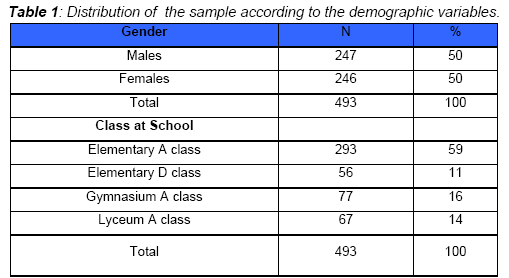
A chronic medical condition was traced in 19 children. The frequency of chronic illness were higher in females (63%) than males (37%). (Table 2).
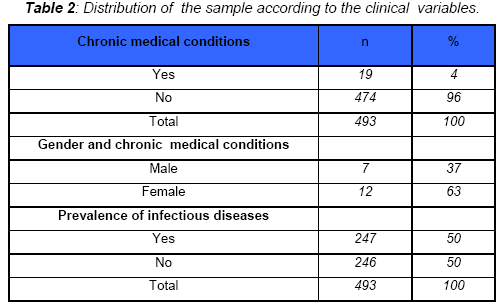
As for infectious diseases, an infectious disease in the past was found in 50% (247) of the students. Rubella, scarlet fever, and measles were more frequent in females, percentages 8 %, 5 % and 3 % respectively, while the frequency of chicken pox was high in both sexes, predominantly in males (94% vs 84% in females). Infectious mononucleosis was found in one boy. (Table 3)
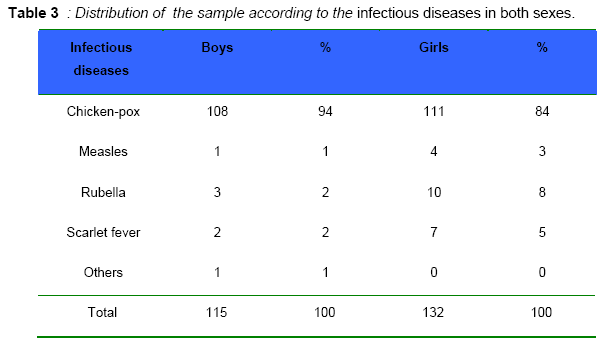
Full vaccination coverage reached 54% (268), while the level of incomplete coverage was 37 % (181). 9% of the children had no PHC available, while 2 children had undergone no vaccination at all. (Table 4).
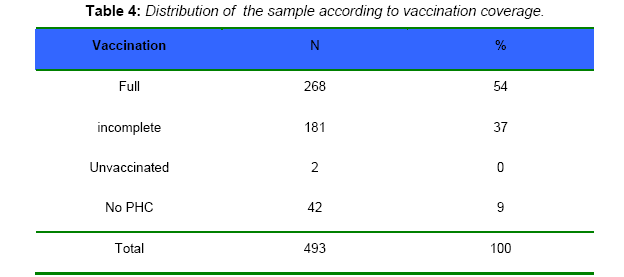
In males, 133 children (54%) were fully vaccinated, 84 (34%) incomplete, 2 (1%) not ever vaccinated and 28 individuals (11%) had no PHC. In females, the percentages were 55%,(135), 39% (97), 6% (11), respectively, while there was not any unvaccinated girl. (Table 5).
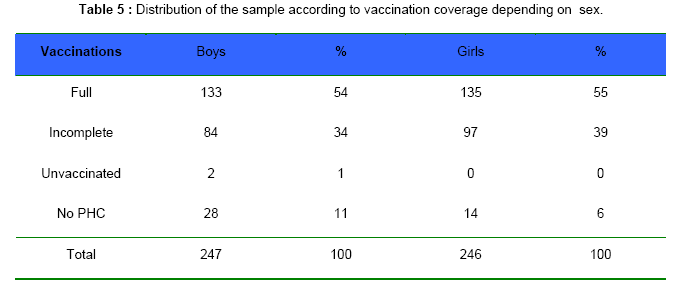
Missing doses distribution were as follows: polio (Sabin) 6 % (16), DΤ ( adult) 21 % (61), MMR 48 % (134) , Hepatitis B 25 % (70). No missing dose was traced in DTP vaccination. The distribution of mandatory vaccination is described in table 6.
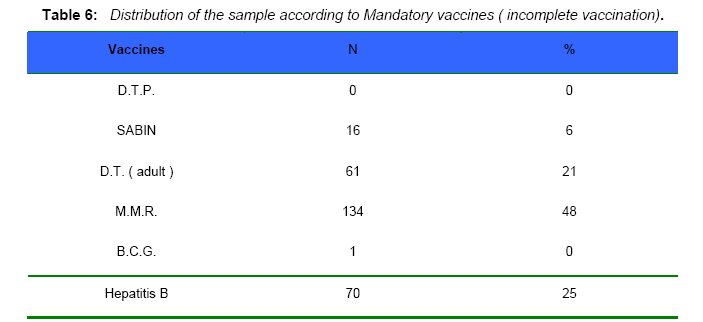
The x2 test reveals that percentages of full vaccination in the present study differed statistically significant from the corresponding percentages in other European countries, such as France, Luxemburg and Germany. (Table 7).

DISCUSSION
According to the findings of the present study, the vaccination coverage in childhood is over 90%. However, full vaccination coverage in infancy (3 doses until 12 months of age) hardly reaches 82%. Previous studies in Greece have shown that the vaccination coverage for poliomyelitis ranged from 82,6% in the island of Crete ( the lowest), to 99% in Amfissa (a municipality in central Greece) [7,8]. Far behind the above percentages is the vaccination coverage in gypsies subpopulation, which barely exceeds 20% [9].
A possible explanation for the results is that Massive polio vaccination is mandatory in Greece. It was implemented in 1960’s (initially Salk vaccine, then Sabin). In other European countries the percentages exceed 95%10. Coverage against tetanus diphtheria and pertussis (DTP vaccination) is at high levels (above 90% ), in accordance with most countries worldwide [11-13].
As for MMR vaccination, a low coverage was found in the present study. However satisfactory percentages (over 80%, with the exception of few remote geographical regions) are reported in Greece with the highest percentage in adolescents in Larissa of central Greece [14]. Full MMR vaccination is in doubt as, in a recent study, low percentages of full vaccination were found in adolescents from various provinces in Greece ,around 57% [14].The most missed dose was the final booster one. This phenomenon is present worldwide, although it is excessively common in some countries. The rates found in the present study are far behind those of many European countries [14].
It is noticeable that a large part of elementary school children have been vaccinated against tuberculosis. Great differences are reported depending on area and population sample. In an urban area of Athens (middle-class income on average) 80% of children under 12 had not been vaccinated, while in two other towns (Larissa, central Greece and Argos in the South)4 the percentages of vaccination coverage reached 95%. In gypsies, central Greece, coverage was restricted to 41% [9]. However the efficacy of BCG is in doubt worldwide. There are contradictory findings regarding its protection, even in infancy. In this age the protection against military tuberculosis or tuberculus meningitis was thought to be satisfactory in the past. Studies from aboriginals in Alaska had showed a mean long term protection of 52% [17].
Percentages of vaccination coverage against hepatitis B virus in the general population in Greece range from 80 % to almost 100 % . In Gypsies, however, which is a population group of special interest in terms of public health policy, the full coverage is extremely low, approximately 4%. Even first dose was administered only to 22 % of the children. Gypsies in general face vaccination problems vaccination problems [18]. Problems in vaccination coverage against HBV is not limited in social subpopulations or in certain countries. At school entry, however, in 1997 only 10% of the children in seven West German states showed serological evidence of HBV vaccination coverage [19]. In 1995, hepatitis B virus (HBV) vaccination was included in the infant immunization schedule in France. However, the emotion generated by the claim that HBV vaccination could have led to the development of central nervous system demyelinating disorders resulted in a marked decline of HBV vaccine use, both in the paediatric (23.3% vaccination coverage in children less than 13 years old) and in the adult population [20].
The rapid reduction in the prevalence of infectious diseases (below 5%) has lead public health services to low levels of alertness. On the other hand, recording of vaccination could hardly considered as satisfactory.8 Data are provided by public services only that are responsible for 18% percent of children at maximum, while most vaccinations take place in private office practice. Data collection in this study refers to schoolchildren in general, no matter if they attend private offices or public settings. However, the low prevalence of infectious diseases in Greece leads to the assumption of a rather satisfactory immunization coverage of children [21].
The vaccination coverage in the sample of this study is considered rather high. Nevertheless when it is adapted for age is lower in comparison to other developed countries or W.H.O goals for European South. The problem is getting worse with increasing age. Even in young adults attending health sciences the vaccination rates ranged from 65.2% for the oral polio (SABIN) vaccine and 65.7% for the hepatitis B virus vaccine to 74.6% for the diphtheria-tetanus-pertussis (DTP) vaccine [22]. It is necessary a co-ordinated action to take place and an evidence based decision to be made on national immunization programs [23,24].
Conclusions
Vaccination is an important component of control and prevention of infectious diseases. School Based Vaccination Programs provide parents with the opportunity to have their children vaccinated against a number of diseases through their school.It is a matter of great importance to increase both national immunization rates by such vaccination programs and communicating information about immunization to the general public and health professionals.
5294
References
- Gostin LO. International Infections. Disease Law-Revision of WHO's International Health Regulation. JAMA. 2004; 291: 2623-7.
- Murray TS., Groth ME., Witzman C., Cappello M. Epidemiology and management of infectious diseases in international adoptees. ClinMicrobiol Rev. 2005;18: 510-20.
- Adekoya N. Infectious diseases treated in emergency departments united States. J health Care Poor Underserved. 2005;16: 487-96.
- Κανακούδη-Τσακαλίδου Φ. Εμβολιασμοί 2005.Νέα Εμβόλια στο Εθνικό Πρόγραμμα Εμβολιασμών. Παιδιατρική Βορείου Ελλάδος. 2005;17:213-230.
- Cohn AC., Broden KR., Pickering L.K. Immunization in the United States: A Rite of Passage. PediatrClin Ν Am 2005;52: 669-9.
- Schmitt HJ., Booy R., Weil-Olivier C., Van Damme P., Cohen R., Peltola H. Child vaccination policies in Europe: a report from he summits of independent European vaccination Experts. Lancet Infect Dis. 2003; 3: 103-108.
- Ταβλάντα Μ., Κορρές Ν., Καμπόσος Π., Αλεξοπούλου Σ., Μπαρμπούτη Κ., Πολλάλης Π., Ταβλάντα Σ. Προληπτικοί έλεγχοι και καταγραφή των εμβολιασμών σε παιδιά σχολικής ηλικίας Άργους-Ναυπλίας του Νομού Αργολίδας. Νέα Παιδιατρικά Χρονικά. 2005; 2: 109-116.
- GavanaΜ.,Tsoukana Ρ., Giannakopoulos Ε., Smyrnakis Ε., and Benos A. Adequacy of vaccination coverage at school-entry: Cross-sectional study in schoolchildren of an urban population. Archives of Hellenic Medicine. 2005;22 :358-369.
- Παραλίκας Θ., Τζαβέλας Γ., Ραφτόπουλος Β., Παπαθανασίου Ι., Λαχανά Ε., Κυπαρίση Γ. Διερεύνηση της συμπεριφοράς των τσιγγάνων της Θεσσαλίας σε θέματα υγείας. Νοσηλευτική. 2005; 44 :364-371.
- Ahmad K. WHO Steps Up Fight Against Poliomyelitis. Lancet Neurol. 2003; 2:586.
- Poethko-Miiller C., Kuhnert R., Schlaud M. Vaccination coverage and predictors for vaccination level. Results of the
- German Health Interview and Examination Survey for children and Adolescents. BundesgesundheitsblattGesundheitsforschungGesundheitsschutz. 2007; 50:851-62.
- Mossong J., Putz L., Shkedy Z., Schneider F. Seroepidemiology of diphtheria and pertussis in Luxembourg in 2000. Epidemiol Infect. 2006; 134:573-8.
- Bitsori M., Ntokos M., Kontarakis N., Sianava O., Ntouros T., Galanakis E. Vaccination coverage among adolescents in certain provinces of Greece. ActaPaediatr. 2005; 94:1122-5.
- Mossong J., Putz L., Schneider F. Seroprevalence of measles, mumps and rubella antibodies in Luxembourg: results from a national cross-sectional study. Epidemiol Infect. 2004; 132:11-18.
- Bonmarin I., Levy-Bruhl D. Measles in France: the epidemiological impact of suboptimal immunization coverage. Euro Surveill. 2002; 7:55-60.
- Vesikari T., Sadzot-Delvaux C., Rentier B., Gershon A. Increasing coverage and efficiency of measles, mumps, and rubella vaccine and introducing universal varicella vaccination in Europe: a role for the combined vaccine. Pediatr Infect Dis J. 2007; 26:632-8.
- Boran C., Coban Y.K., Sasmaz S., Parmaksiz G. Huge Keloid Formation after BCG Vaccination. PediatrDermatol 2003; 20: 460.
- Martinez-Campillo Garcia F., Maura da Fonseca A., Santiago Oliva J., Verdu Perez M., SerramiadelPrisco A., Ibanez Molina M., Martinez Miralles P., Rigo Medrano MV. Vaccine coverage study and intervention with health community agents in a marginal gypsy community of Alicante. AtenPrimaria. 2003; 31:234-8.
- Kramer A., Prufer-Kramer L. Experience with the new German hepatitis Β vaccination strategy since 1995. Int J STD AIDS. 2002, 13 Suppl 2:35-7.
- Denis F., Levy-Bruhl D. Mass vaccination against hepatitis B: the French example. Curr Top MicrobiolImmunol. 2006; 304:115-29.
- Θωμαΐδης Θ., Λάγγας Δ. Επιδημιολογικά Δεδομένα των Εμβολιασμών στην Ελλάδα. Ελληνική Παιδιατρική Εταιρεία. Αθήνα , 2000, σελ.23-40.
- Noula M., Raftopoulos V., Gesouli Ε., Tsaprounis T., and DeltsidouA.Greek nursing students' immunization coverage: Data from central continental Greece Nursing and Health Sciences. 2008;10: 169-174.
- Kimman TG., Boot HJ., Berbers GA., Vermeer-de Bondt PE., Ardine de Wit G., de Melker HE. Developing a vaccination evaluation model to support evidence-based decision making on national immunization programs. Vaccine. 2006; 24:4769-78.
- Noula M., Gesouli E., Mastrogiannis D., Raftopoulos V., Tsetsekou E. Vaccination coverage in primary school children of urban and sub-urban population in central Greece. Medical Annals.2008;31: 486-490.












